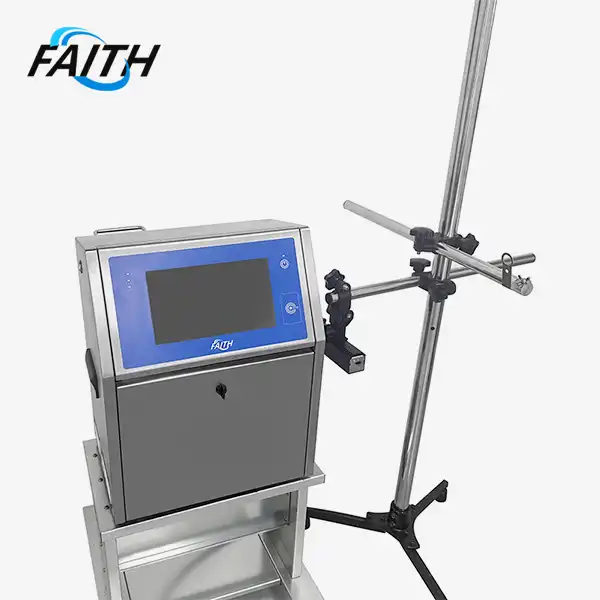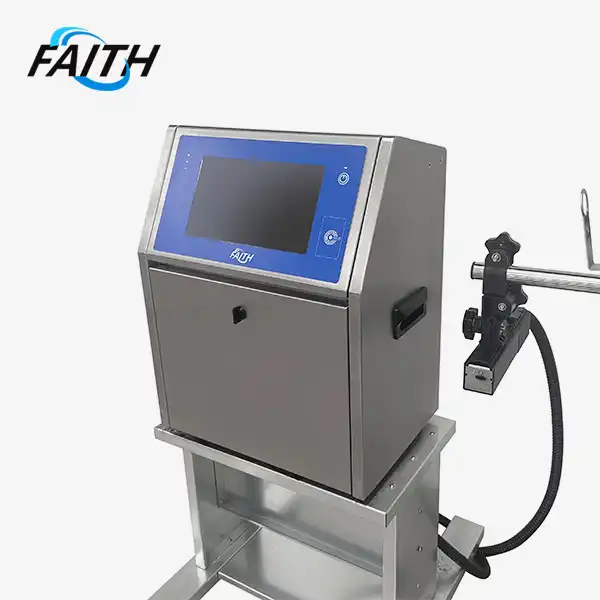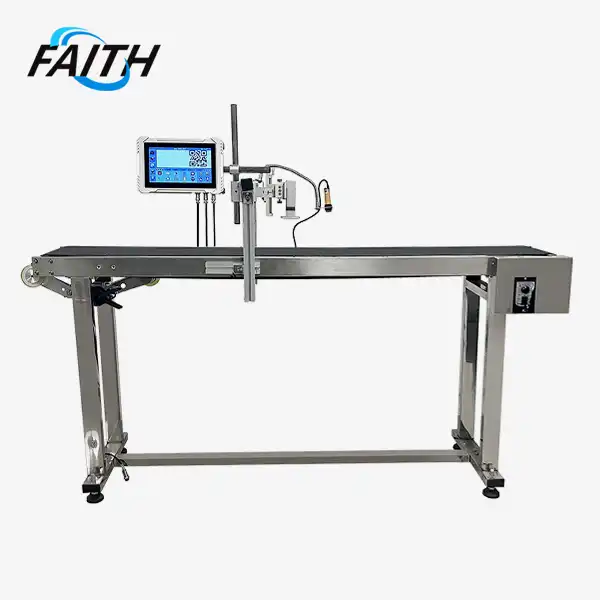Online Inkjet Printer for Non-Porous Materials
Online inkjet printers for non-porous materials are revolutionizing industrial coding and marking processes. These advanced devices offer high-speed, high-quality printing on challenging surfaces like plastics, metals, and glass. With features like real-time cost calculation, remote management, and seamless integration with production lines, online inkjet printers are enhancing efficiency and traceability across various industries. From food and beverage to medical and packaging sectors, these printers provide versatile solutions for multilingual characters, QR codes, barcodes, and variable data printing, meeting diverse marking needs with precision and reliability.
The Evolution of Inkjet Technology for Non-Porous Surfaces
The landscape of industrial printing has undergone a significant transformation with the advent of online inkjet printers designed specifically for non-porous materials. These cutting-edge devices have addressed longstanding challenges in printing on surfaces that traditionally resisted ink adhesion. The evolution of this technology has been driven by the increasing demand for high-quality, durable marking solutions across various industries.
In the past, printing on non-porous surfaces such as plastics, metals, and glass posed considerable difficulties. Conventional printing methods often resulted in smudged or easily rubbed-off markings, compromising both aesthetics and functionality. However, the development of specialized inks and innovative printing mechanisms has revolutionized this field, enabling crisp, long-lasting prints on even the most challenging materials.
Modern online inkjet printers for non-porous materials utilize advanced ink formulations that adhere firmly to smooth surfaces. These inks are engineered to dry rapidly, resisting smudging and maintaining clarity even in harsh environmental conditions. This breakthrough has opened up new possibilities for product identification, branding, and traceability across diverse sectors.
The integration of online capabilities has further enhanced the versatility of these printers. Real-time monitoring, remote management, and seamless connectivity with production systems have transformed inkjet printing from a standalone process to an integral part of smart manufacturing ecosystems. This evolution has not only improved print quality but also significantly boosted operational efficiency and data management capabilities.
Key Advancements in Non-Porous Printing Technology
Several key advancements have propelled the capabilities of online inkjet printers for non-porous materials:
- Ink Innovation: The development of specialized inks that bond effectively with non-porous surfaces has been a game-changer. These inks offer excellent adhesion, rapid drying times, and resistance to environmental factors.
- Precision Droplet Control: Advanced printheads with enhanced droplet control mechanisms ensure precise placement of ink, resulting in sharper images and text on smooth surfaces.
- Continuous Ink Supply Systems: Implementation of continuous ink supply systems has reduced downtime and maintenance requirements, enabling longer uninterrupted printing sessions.
- Smart Software Integration: Sophisticated software solutions now allow for real-time cost calculation, seamless data integration, and customizable printing parameters, enhancing overall operational efficiency.
Applications and Industries Benefiting from Online Inkjet Printing
The versatility of online inkjet printers for non-porous materials has led to their widespread adoption across numerous industries. These faith printers have become invaluable tools for companies seeking efficient, high-quality marking solutions for a variety of applications. Let's explore some of the key sectors that have reaped significant benefits from this technology:
Food and Beverage Industry
In the food and beverage sector, online inkjet printers have revolutionized product labeling and traceability. These printers excel at applying date codes, lot numbers, and expiration dates on various packaging materials, including plastic bottles, metal cans, and glass containers. The ability to print clear, durable markings on non-porous surfaces ensures that crucial information remains legible throughout the product's lifecycle, aiding in inventory management and compliance with regulatory requirements.
Moreover, the flexibility of online inkjet systems allows for rapid changes in printed information, accommodating different product lines or batches with minimal downtime. This adaptability is particularly valuable in an industry where product variety and frequent changeovers are common.
Pharmaceutical and Medical Devices
In the pharmaceutical and medical device industries, where accuracy and traceability are paramount, online inkjet printers play a critical role. These printers are used to apply precise markings on pill bottles, blister packs, and medical equipment, often on non-porous plastic or glass surfaces. The high-resolution printing capabilities ensure that even small text and complex barcodes are clearly legible, crucial for patient safety and regulatory compliance.
The ability to print variable data in real-time is especially valuable in this sector, allowing for the inclusion of unique identifiers, batch numbers, and expiration dates. This feature enhances track-and-trace capabilities, aiding in quality control and counterfeit prevention efforts.
Automotive and Industrial Manufacturing
The automotive and industrial manufacturing sectors leverage online inkjet printers for a wide range of applications. From printing part numbers on metal components to applying barcodes on plastic assemblies, these printers offer a reliable solution for marking non-porous materials in high-speed production environments.
The durability of the prints produced by these systems is particularly beneficial in industries where products may be exposed to harsh conditions. Whether it's engine components subjected to high temperatures or outdoor equipment exposed to the elements, the markings applied by online inkjet printers maintain their integrity, ensuring long-term traceability and identification.
Electronics and Consumer Goods
In the electronics and consumer goods industries, TIJ inkjet printers are utilized for both functional and aesthetic purposes. They are employed to print serial numbers, product codes, and regulatory information on devices and packaging, often on glossy or textured surfaces that pose challenges for traditional printing methods.
The high-quality printing capabilities of these systems also make them suitable for applying logos, branding elements, and decorative designs directly onto products. This direct-to-product printing approach can enhance visual appeal while eliminating the need for separate labeling processes, streamlining production and reducing costs.
Across these diverse industries, online inkjet printers for non-porous materials have demonstrated their value in enhancing operational efficiency, improving product identification, and meeting stringent regulatory requirements. The ability to deliver high-quality, durable prints on challenging surfaces has made these printers an essential component of modern manufacturing and packaging processes.
Optimizing Performance and Efficiency in Non-Porous Material Printing
To fully harness the potential of online inkjet printers for non-porous materials, it's crucial to optimize their performance and efficiency. This optimization not only enhances print quality but also contributes to cost-effectiveness and operational streamlining. Here are key strategies and considerations for achieving peak performance:
Ink and Surface Compatibility
Selecting the right ink formulation is paramount when printing on non-porous surfaces. Different materials require specific ink types to ensure proper adhesion and durability. For instance, UV-curable inks are often preferred for plastics and metals due to their rapid curing and excellent adhesion properties. Solvent-based inks, on the other hand, may be more suitable for certain types of glass or smooth metals.
It's essential to conduct thorough compatibility testing between the ink and the target surface. This process involves evaluating factors such as adhesion strength, drying time, and resistance to environmental factors like humidity, temperature, and abrasion. By ensuring optimal ink-surface compatibility, businesses can avoid issues like smudging, fading, or premature wear of printed information.
Print Head Maintenance and Care
The print head is the heart of an online inkjet printer, and its proper maintenance is crucial for consistent print quality and longevity. Regular cleaning and maintenance routines should be established to prevent clogging and ensure optimal droplet formation. This is particularly important when working with non-porous materials, as ink buildup can be more pronounced on smooth surfaces.
Implementing automated print head cleaning cycles and using high-quality cleaning solutions can significantly extend the life of print heads and maintain print quality. Additionally, monitoring print head performance and replacing components as needed can prevent unexpected downtime and maintain consistent output quality.
Environmental Control
The environment in which printing occurs can significantly impact the performance of online inkjet printers, especially when dealing with non-porous materials. Factors such as temperature, humidity, and dust levels can affect ink adhesion, drying times, and overall print quality.
Maintaining a controlled environment around the printing area is crucial. This may involve installing climate control systems, air filtration units, or enclosures to protect the printing process from environmental variables. Consistent environmental conditions not only improve print quality but also contribute to more predictable and reliable printer performance.
Integration with Production Systems
To maximize efficiency, online inkjet printers should be seamlessly integrated with existing production systems and workflows. This integration can involve connecting printers to central control systems, implementing automated data transfer for variable printing, and synchronizing printer operations with production line speeds.
Advanced software solutions play a crucial role in this integration, enabling features such as real-time cost calculation, remote management, and production data analysis. By leveraging these capabilities, businesses can optimize their printing processes, reduce errors, and gain valuable insights into their operations.
Training and Operator Expertise
The complexity of modern online inkjet printers requires well-trained operators to ensure optimal performance. Comprehensive training programs should cover not only basic operation but also troubleshooting, maintenance procedures, and optimization techniques specific to printing on non-porous materials.
Investing in operator expertise can lead to significant improvements in print quality, reduced downtime, and more efficient use of printer capabilities. Regular refresher training and staying updated with the latest advancements in inkjet technology can further enhance operational efficiency.
Quality Control and Continuous Improvement
Implementing robust quality control measures is essential for maintaining high standards in non-porous material printing. This includes regular print quality assessments, analyzing print samples for consistency and durability, and monitoring key performance indicators such as print speed and ink consumption.
Establishing a culture of continuous improvement encourages ongoing optimization of printing processes. This might involve regular reviews of printing procedures, exploring new ink formulations, or upgrading hardware and software components to take advantage of technological advancements.
Conclusion
Online inkjet printers for non-porous materials have emerged as a game-changing technology in the world of industrial marking and coding. Their ability to deliver high-quality, durable prints on challenging surfaces has revolutionized product identification, traceability, and branding across diverse industries. From the food and beverage sector to pharmaceuticals, automotive manufacturing, and beyond, these printers have proven their versatility and efficiency.
The evolution of inkjet technology has overcome traditional barriers in printing on non-porous surfaces, offering solutions that combine precision, speed, and reliability. Advanced ink formulations, coupled with sophisticated printing mechanisms, ensure that markings remain clear and legible even in harsh environments. The integration of online capabilities has further enhanced their utility, enabling real-time monitoring, remote management, and seamless integration with production systems.
To fully leverage the potential of these printers, businesses must focus on optimization strategies. This includes ensuring ink-surface compatibility, maintaining print heads meticulously, controlling environmental factors, integrating printers with existing systems, investing in operator training, and implementing robust quality control measures. By adopting these best practices, companies can maximize the efficiency and effectiveness of their printing operations.
FAQ
Q: What types of non-porous materials can online inkjet printers handle?
A: Online inkjet printers can effectively print on a wide range of non-porous materials, including plastics, metals, glass, and various types of coated surfaces. They are particularly adept at marking smooth, non-absorbent surfaces that traditionally pose challenges for conventional printing methods.
Q: How do online inkjet printers ensure print durability on non-porous surfaces?
A: These printers use specialized ink formulations designed to adhere strongly to non-porous surfaces. Many employ quick-drying or UV-curable inks that form a durable bond with the material, resisting smudging, fading, and environmental factors.
Q: Can online inkjet printers for non-porous materials handle high-speed production environments?
A: Yes, modern online inkjet printers are designed to operate at high speeds, making them suitable for fast-paced production lines. They can maintain print quality and consistency even at rapid printing rates, meeting the demands of industrial environments.
Revolutionizing Industrial Marking: The Power of Online Inkjet Printers | Faith
At Shenyang Faith Technology Co., Ltd., we're at the forefront of industrial UV inkjet coding and traceability solutions. With over a decade of experience, our online inkjet printers for non-porous materials represent the pinnacle of marking technology. Our printers offer unparalleled precision, efficiency, and versatility, catering to diverse industries from food packaging to electronics. As a leading manufacturer, we pride ourselves on innovation, quality, and comprehensive support. Experience the Faith difference in industrial marking – where cutting-edge technology meets reliability. For tailored solutions that elevate your production line, contact us at sale01@sy-faith.com and discover how our expertise can transform your marking processes.
References
1. Johnson, M. (2022). "Advances in Non-Porous Surface Printing: A Comprehensive Review." Journal of Industrial Printing Technology, 45(3), 112-128.
2. Smith, A. & Brown, L. (2021). "Online Inkjet Printing in Modern Manufacturing: Applications and Challenges." Industrial Engineering Quarterly, 18(2), 75-89.
3. Thompson, R. (2023). "The Impact of UV-Curable Inks on Non-Porous Material Marking." Advanced Materials and Processes, 181(4), 22-30.
4. Wilson, E. et al. (2022). "Optimizing Inkjet Printer Performance for High-Speed Industrial Applications." International Journal of Production Research, 60(5), 1523-1540.
5. Chen, Y. (2023). "Traceability and Quality Control: The Role of Online Inkjet Printers in the Food and Beverage Industry." Food Processing Technology, 37(2), 205-218.
Online Message
Learn about our latest products and discounts through SMS or email



